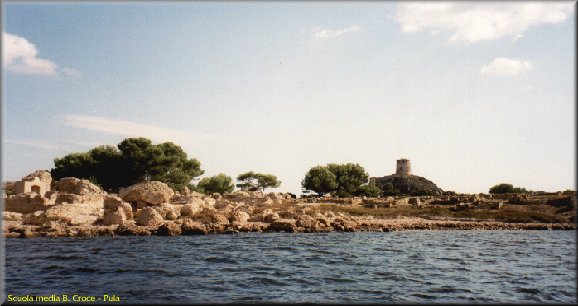Português Dutch |
Nora |
Français Italiano |
![]()
Most probably Nora’s site was anciently inhabited by nuraghi population: some ceramics remains dated back to the nuraghi civilisation have been found in an area called “Punta di Coltellazzo”. And in the South-East corner of the thermal baths, near the sea, there is a nuraghi well (that hasn’t been excavated as yet) with several steps that go down to the water. At the moment no other nuraghi remain has been found within the ancient town area, but it is most probable that the tower of Coltellazzo has been built over an older nuraghi tower. Whereas the hinterland is quite rich of nuraghi buildings: on the hill of “Sa Guardia Mongiasa”, quite close to the town, there are the remaining of a small nuraghe.

Nora - V
About the
Phoenician colonization we have more certain information. The Greek historian Pausania, tells that
the Iberian, led by Norax, arrived to Sardinia and founded the first town: Nora. Since the Phoenicians had the trade control on the Iberian
peninsula, the historians believe that the Iberians who founded Nora were
actually Phoenicians.
Some
Phoenician stone inscriptions dated VIII century b.C., found in Nora, indicate
that the town must have been the first in Sardinia.
The
Phoenician sailors came from the sea, not as invaders, but to trade; at first
they started with temporary settlements to be used as storehouses for the raw
materials. Certainly the typology
of the place agreed with the Phoenicians demand, because Nora represents a
sheltered port for the ships in case of storms.
The height of “Coltellazzo” has probably hosted the first urban
centre (about 750 b.C.). The Phoenicians certainly had a commercial and pacific
relationship with the inhabitants of the area. As commerce increased the town grew and expanded over
the promontory all along the lower part of the peninsula.
In the VI
century b.C. the Carthagine marine power (situated on the African North coast). At mid. century the Carthaginian
invaded the West side of Sicily, where they the towns of the Magna Grecia put up resistance.
At the end they forwarded towards Sardinia and attacked the Phoenician
towns. A first expedition headed by
general Malco was defeated, but by the end of the century a second expedition
led by the generals Asdrubale and Amilcare obtained the alliance with Tharros (near
Oristano) and Karalis (Cagliari). The
Carthaginian conquered also Sulcis and Nora, that had opposed resistance, hence
from 509 b.C. Sardinia became a Carthaginian domain.
There are not
many Phoenician archaeological remains in Nora, we may count the foundations of
the Temple of Tanit, the fortifications on the “Punta di Coltellazzo” and
some ruins of houses and walls. The
Romans have built over all the Carthaginian buildings so very little is visible.
During the
Carthaginian domain Nora became important for the maritime trade throughout the
Mediterranean, as evidenced by the rich ornaments and linens found in the Punic
tombs: ceramics, Greek pieces of jewellery, talismans, African or Italian
jewellery. The town
must have been quite rich and active. Probably
the Carthaginian market “Piazza” was where we can still see the remains of
the Roman forum. It must have
been the centre of a dense trade exchange: there was copper coming form central
Sardinia, Etruscan dishes, attic ceramics, lead and silver from Sulcis (in
Sardinia), gold from Sahara, copper objects coming from Cyprus, handicrafts in African ivory.
Very few traces remain of the Punic town, such as the Tophet and the
necropolis destroyed by the sea.
In 238 b.C.,
Sardinia was conquered by the Romans, therefore also Nora passed under the Roman
domain. It started off as the main
town of the island and the governorship’s site, but soon Karalis took its
place.
Anyhow also
later on Nora remained an important town: it was “Caput Viae” (town cape of
a road, from which distances were calculated).
The importance of the town was testified by the presence of four (not
one) Thermal Buildings, of a theatre and an amphitheatre (not yet excavated) and
of some elegant villas situated at a certain distance from the urban centre of
the town. The common
people’s houses were quite small and usually consisted in a single room at the
bottom with a wooden intermediate floor on top used as bedroom.
The
archaeological findings preserved in Pula Museum give a good idea of the daily
routine of the town: there are common use objects built in Nora or imported from
the various Mediterranean coasts.
The slow
decline of Nora began in the IV century a.C., with the falter of the Roman
Empire and when the seas became unsafe. The
Vandals (455 a.C.) the town ended its vital cycle and was gradually abandoned by
the people who chose safer inland areas.
In the VII
century a.C., the Saracen pirates incursions started and by then Nora was
considered more a “Presidium” (military fortress) than a village.
There are
traces of a fire in the area of the sea thermal baths during the VIII century
a.C. and most probably the area was consequently completely abandoned.
So the story
of Nora lasts the space of 1600 years, from the VIII century b.C. to the VIII
century a.C.
From a project
on Nora performed by the pupils of
Class 2nd C “Scuola media B. Croce” of Pula in school year 1997/98
![]()
